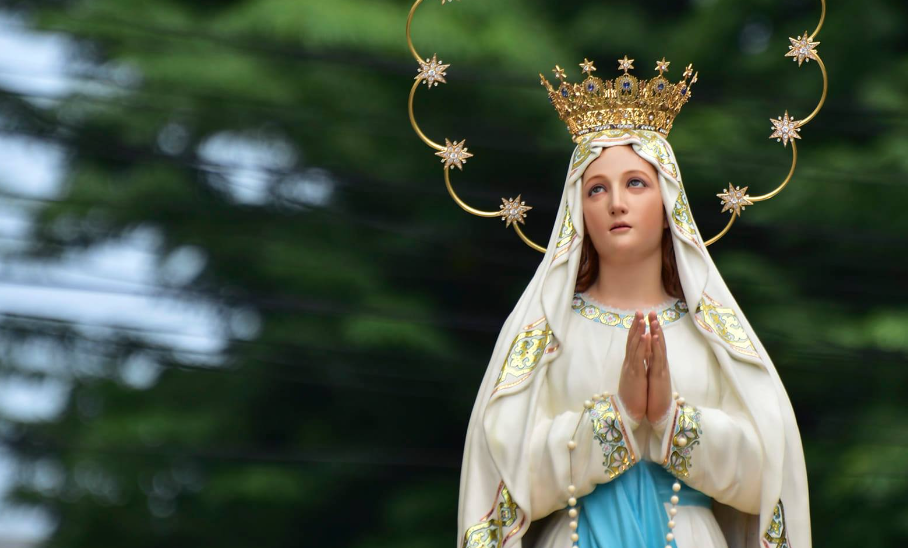
In the boundary of Manila – Quezon City, where Retiro is located, lies the Shrine where the historic, beautiful, and miraculous image of Our Lady of Lourdes is enshrined and venerated at the Capuchin Church and National Shrine in this area.
Our own beautiful Lady in the grotto has lavished her devotees with abundant graces through the centuries and it continues to be strong as the years go by – just as how the miracles are very abundant in her actual shrine in Lourdes, France.
The image
There were two images of Our Lady of Lourdes enshrined at the National Shrine of Our Lady of Lourdes of Quezon City, the smaller older image kept at her own chapel near the entrance which is the oldest existing image of Our Lady of Lourdes in the Philippines and the Pontifically Crowned altar image of Our Lady of Lourdes. Both of the images are looking upward and wear crowns and the diagnostic “doce estrellas” for Philippine santos.
The images are faithful to the description of the Blessed Virgin as seen by St. Bernadette Soubirous – the visionary of Lourdes: “She has the appearance of a young girl of sixteen or seventeen. She is dressed in a white robe, girdled at the waist with a blue ribbon, which flows down all along her robe. She wears upon her head a veil that is also white; this veil gives just a glimpse of her hair then falls down at the back below her waist. Her feet are bare but covered by the last folds of her robe except at the point where a yellow rose shines upon each of them. She holds on her right arm a Rosary of white beads with a chain of gold shining like the two roses on her feet.”
The Lourdes Apparitions
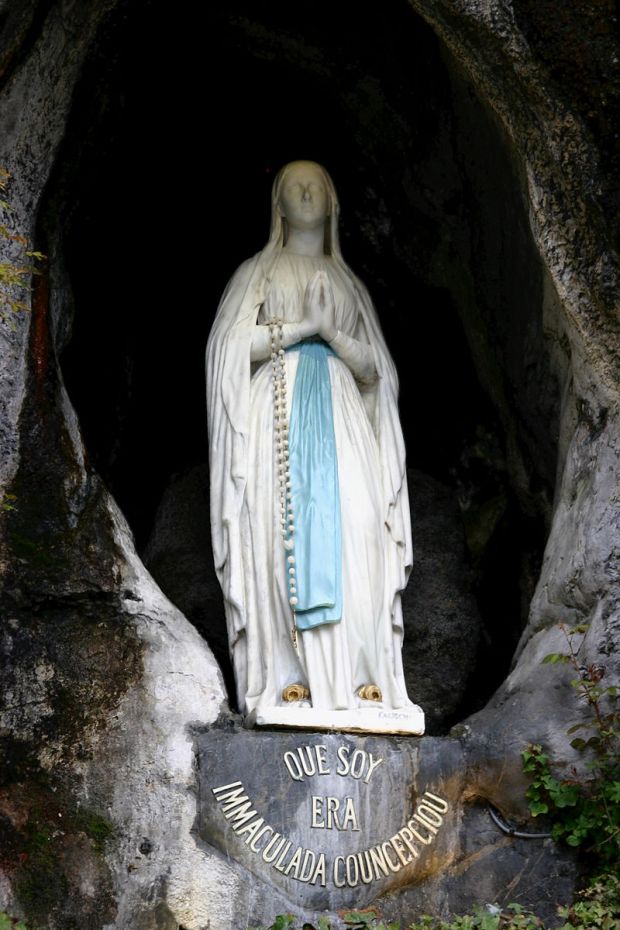
At the Grotto of Massabielle on February 11, 1858, the Virgin showed herself 18 times to Bernadette Soubirous. Under the title “The Immaculate Conception,” she called for penance and prayer for the conversion of sinners.
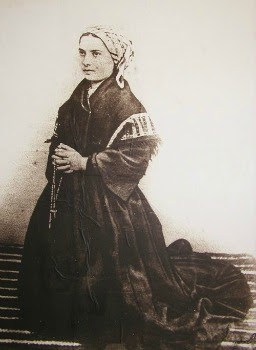
During the apparitions, a spring was found in the area of the grotto dug by St. Bernadette herself, as instructed by Our Lady, and the spring caused miraculous cures and this added to the fame of the Lourdes apparitions to this day. In 1859, Professor Vergez of the Faculty of Medicine at Montpellier was appointed to examine the cures. Seven cures were recorded before 1862 promoting the argument for the recognition of the Apparitions by Bishop Laurence. Over 5,000 cures have been documented in the waters of Lourdes. The Church has vigorously investigated and validated 69 of them.
After a 4-year investigation commission, the bishop of the Diocese of Tarbes declared on January 18, 1862: “We judge that Mary Immaculate, Mother of God, really appeared to Bernadette Soubirous on February 11, 1858, and on subsequent days, eighteen times in all. The faithful are justified in believing this to be certain.” The Feast Day of Our Lady of Lourdes is February 11th as decreed by Pope Leo XIII.
Bernadette Soubirous later entered religious life in 1866 with the Sisters of Nevers. She was given the name of Sister Mary Bernard and worked there as a sacristan and avoided publicity as best she could. She referred to herself as “a broom which Our Lady used, but now I have been put back in my corner.” She died on April 16, 1879, at the age of 35 and was buried in St. Gildard Convent in Nevers. Years later in 1925, her body is exhumed and found to be incorrupt. She was beatified in 1925 by Pope Pius X and on December 8, 1933, on the Feast of the Immaculate Conception, Bernadette is canonized a saint by Pope Pius X.
The Lourdes Virgin and the Capuchins
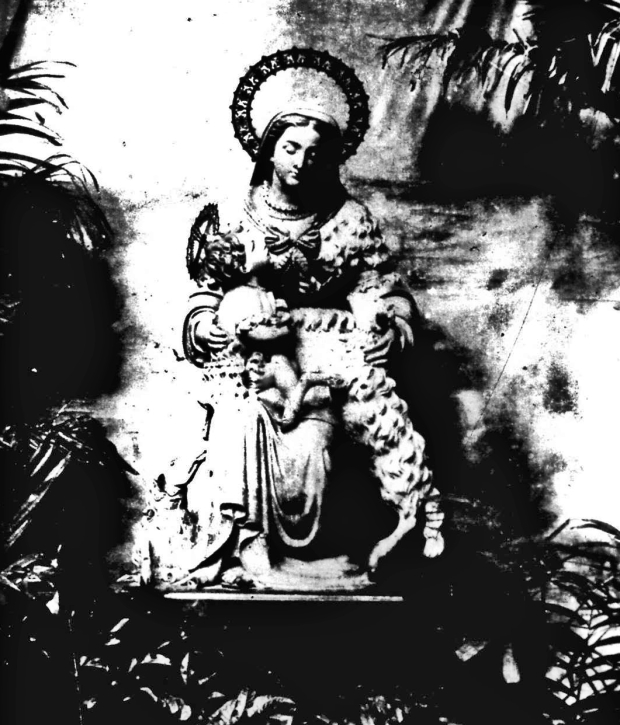
The Order of the Franciscan Capuchins, or the reformed Franciscan Order, was responsible for bringing devotion to Our Lady of Lourdes in the country, years after the formal approval of the Church of the Lourdes apparitions of 1858.
The Capuchin Order arrived on the shores of Manila on May 13, 1886, first as a satellite area for their missions in the Oceania islands until they later formally settled in Intramuros. The order’s first chapel opened by the Capuchins to the public was initially dedicated to La Divina Pastora – the Patroness of the Order where a Capuchin in Seville saw the Blessed Virgin as La Divina Pastora (The Divine Shepherdess) and propagated the devotion to all over Spain and its colonies as part of their missions.
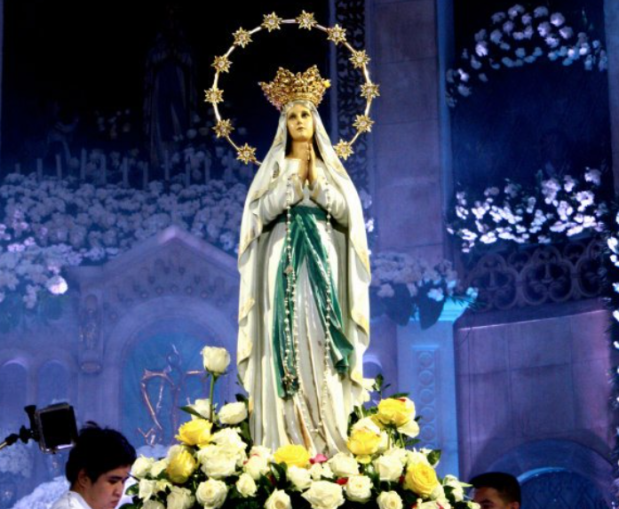
In September of 1892, Rev. Fr. Berardo de Cieza, OFM Cap, then the Superior of the Central House requested the famed sculptor at that time Manuel Flores to sculpt an image of Our Lady of Lourdes. The image, later called “La Primera Imagen”, was meant to be placed in the grotto of the garden, however because of its exquisite beauty the people felt that it would be a pity to leave it exposed to the elements of nature, thus, Fr. Berardo of Cieza prepared a side altar within the chapel to place the statue of Our Lady of Lourdes, thus the devotion to the Lady of the Grotto of Masabielle began that in 1893, the first novena to Our Lady of Lourdes was launched.
The development of the devotion

On May 23, 1893, Reverend Fr. de Cieza OFM Cap. requested His Excellency, Monsignor Bernardino Nozaleda, OP, Archbishop of Manila, to establish the Confraternity of Our Lady of Lourdes in the country. On September 15, 1893, the Archbishop issued a decree declaring the canonical erection and foundation of the Chapel of Capuchins as the Confraternity of the Immaculate Conception of the Blessed Virgin Mary of Lourdes. He also approved all the graces corresponding to such a religious society. The confraternity was later elevated to an Archconfraternity by Pope St. Pius X on August 27, 1910, through the Apostolic Letter “Maniliensium Archiepiscopus.” Since then, the Archconfraternity has grown throughout the country, and the popular white dress and blue sash uniform has become widely recognized.
With the growing popularity of the Lady in the Grotto of the Capuchins, a bigger image, which would be the current altar image – the Venerada Imagen – was sculpted once again by Manuel Flores, with the guidance and cooperation of Fr. Antonio de Valencia, OFM Cap, funded by Mrs. Carmen Macan. This second statue was even more beautiful and it was even exclaimed to be more beautiful than the original one in France. The image was first placed on the side altar of the chapel on February 10, 1896, and subsequently, the Primera Imagen was brought inside the convent.
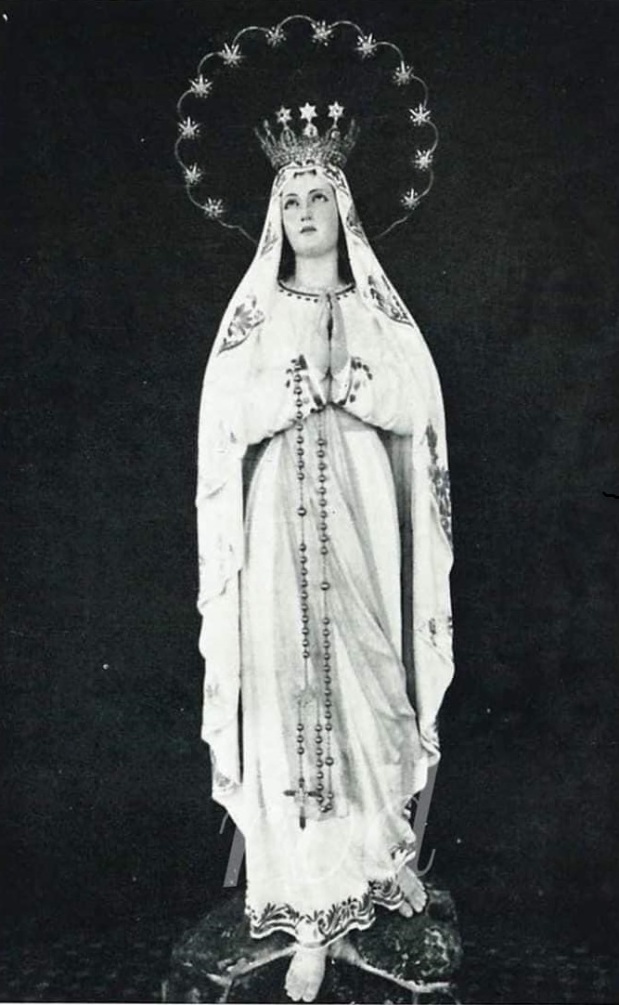
Two French clergymen have seen the venerated image during their visits to the Philippines. The first was the French Archbishop Placide Louis Chapelle, who served as the Apostolic Delegate to the Philippines from 1899 to 1901. The second was Father Michel Daubanes, the Rector of the Sanctuaire Notre-Dame de Lourdes during his visit in 2024, who was also awed by the beauty of the venerated image.
In September 1897, a primitive chapel of the Capuchins was planned to be expanded to accommodate the growing pious exigencies of the devotees. Years later, on February 3, 1910, a new church was dedicated, exclusively built with the contribution of the faithful was inaugurated.
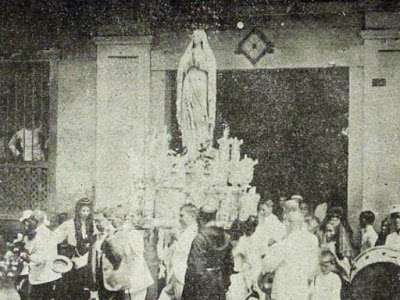
In 1908, the First Procession of the Virgin of Lourdes was held on the occasion of the 50th Anniversary of the Apparitions. An illustrious Catholic Writer, Mr. Manuel Ravago stood up and in brilliant exposition defended that his most opportune extraordinary thing would be to organize a big procession on the last day of the novena. This has been done every year with a multitude of people joining up to this time.
A beautiful tradition was also introduced in Intramuros called the “Ceremonia de Besapies” where the image is brought down from her high altar and the faithful will reverently kiss the feet of the Virgin. It was due to this rite that the altar image became popularly known as the “besa pies” image.
The Miracles
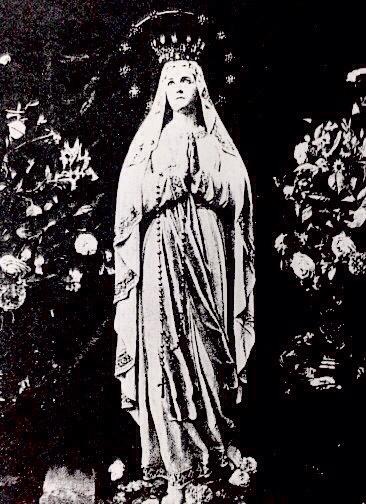
Several miracles were reported through the help of the Lady of Lourdes of the Capuchins, Sometime in 1896, a lady named Martina Azucena was miraculously cured of her incurable illness in front of the statue witnessed by the whole Intramuros population.
In 1898, during the outbreak of the Spanish-American War, moments of anguish waiting for the deadline for surrender were already at hand. Rev. Fr. Alfonso de Morentin, the present Superior of the Capuchin Fathers during that time, prostrated before the venerated image of Lourdes in the name of the whole Capuchin community, gathered at the chapel for the pious exercise of flowers of May, promised solemnly to the Virgin of Lourdes to dedicate to her the new church that they were building if she would save the house and the city of Manila from the terrible destruction of the announced bombing by the Americans.
The deadline for surrender came and Manila did not suffer the fearful effects of the bombs of the Military Fleet of Dewey. Indeed the help and powerful protection from Mary was attained. Fr. Morentin, being faithful to his promise, consecrated to the Virgin of Lourdes the new church. The image of the Virgin of Lourdes was venerated at the main altar and “Te Deum” was solemnly sung at the same time. The Virgin of Lourdes was officially proclaimed the Titular of the Church of the Capuchins, obtained from Rome on February 3, 1897, and on September 24, 1898. Due to the increasing devotion and alms of the faithful, the energetic Fr. Alfonso de Morentin, put in the high altar the image of Our Lady of Lourdes. Since then the Venerada Imagen was enthroned at the main altar of the church and is called by many as “Nuestra Señora de Lourdes de Manila” in the attribution of this miracle.
During the Second World War, though the Church was destroyed, both the first image and the altar image miraculously survived the ravages of the War. In the account of Rev. Fr. Bienvenido Arbeiza, OFMCap., he recounts that when the Capuchin fathers abandoned the church of Lourdes in Intramuros and the central house, they carried with them the images of Our Lady of Lourdes along with her crowns, rosaries, and other jewels.
For the refuge of the Capuchin brothers, they were ordered by their superior to go to San Agustin and placed the images of Our Lady of Lourdes in the wide sacristy of the church. They continued on the daily novena exercises together with the religious of other orders and devotees then it was later transferred to the Chapel of the University of Santo Tomas for Intramuros was no longer safe at that time. With the completion of the new Church of Our Lady of Lourdes, the images were warmly received at her permanent home on August 15, 1951, and devotees flocked to her new shrine through the years. In recent years, a smaller beautiful image of Our Lady of Lourdes was enshrined in a separate chapel which was then the baptistery of the church and pilgrims would also flock to her chapel up to this day.
Church Recognition
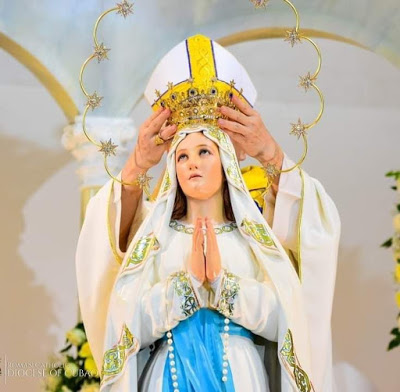
Over the years, numerous devotees continue to flock to her shrine in Quezon City and many can attest to the miracles of our own Lady of the Grotto. On February 3, 1987, Lourdes Church became an Archdiocesan Shrine and, on January 22, 1997, it became the National shrine, the National Shrine of Our Lady of Lourdes.
With these miracles and the favors she granted to her devotees, the Capuchins, and her devotees petitioned for an Episcopal Coronation of the image of Our Lady of Lourdes and it was granted with much solemnity on the Eve of the Solemnity of the Assumption on August 14, 2010, officiated by the His Excellency, Bishop Honesto Ongtioco, Bishop of the Diocese of Cubao.
In 2019, Pope Francis, through the decree issued by the Congregation of Divine Worship and the Discipline of the Sacraments, granted the Canonical Coronation of the venerable image of Nuestra Señora de Lourdes of Quezon City. The beautifully restored image was originally set to receive the honor of Canonical Coronation on May 2, 2020. However, due to the lockdown imposed by the National government due to the rising cases of COVID-19 pandemic victims, the coronation rites were postponed. After a few months, the Canonical Coronation rites finally took place on August 22, 2020 – the Memorial of the Queenship of the Blessed Virgin Mary with resplendent and solemn liturgical rites. The Apostolic Penitentiary granted Plenary Indulgence for the faithful who participated in the rites both physically and virtually from the Coronation day to December 8, 2020 – Solemnity of the Immaculate Conception.
The Devotion at present
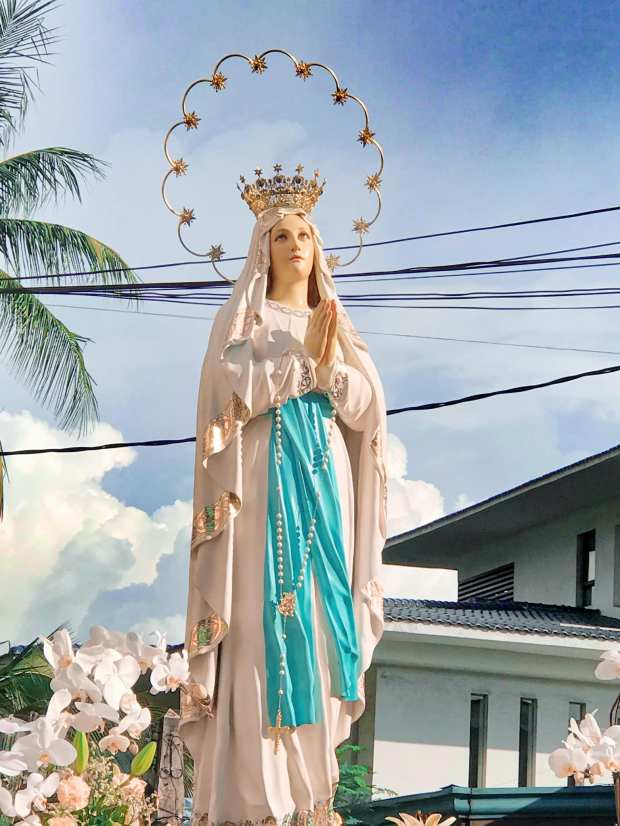
Pilgrims continued to flock to her shrine, especially on Saturdays where healing masses are held for the sick and the infirm. The Feast of the Lady of Lourdes every February 11 will always be marked by her devotees as an important day to visit her Shrine and celebrate her Feast Day with much pomp and solemnity, just like in the olden days back when the two images were enshrined in Intramuros.
We will end this blog dedicated to the Virgin of Lourdes with a commentary by Prof. Pilinio de Oliviera:
“The greatest lesson of Lourdes, then, is the acceptance of suffering, be it a physical illness or a moral sorrow, if it is necessary for our salvation. It is very difficult to carry the cross of suffering with resignation. Yes, it really is. But in such cases, we have the divine example of Our Lord in the Garden of Olives who prayed: “Father, if thou wilt, remove this chalice from me: nevertheless, not my will, but thine, be done” (Luke 22:42). This is the position we should have in face of our particular sufferings. If it is not possible to remove the chalice, “not my will, but thine, be done.” Grace will come to console us, like the Angel who came to console and give strength to Our Lord.
We should have an understanding of suffering, the courage, resolution, and energy it takes to face it, and even the joy to receive it. We should remember that to suffer is a sign of the elect. Our Lady will help us to face our sufferings, just as she helps those who request her assistance at Lourdes.”
Nuestra Señora de Lourdes, Ipanalangin mo kami!
References:
“A Ti Virgen de Lourdes – The Filipinos’ Devotion to Virgen de Lourdes: The Magnet of Multitudes.”, National Shrine of Our Lady Lourdes, Quezon City, 2023.
Arbieza, Bienvenido, OFMCap., “Reseña Historica de los Capuchinos en Filipinas”, Pamplona, Spain, 1969.
Aviado, Lutgarda, “Madonna’s of the Philippines”. Quezon City, 1972.
LeBlanc, Marie FSSP, “Marian Apparitions and Devotions”, Pauline Publications, New York, USA, 1995.
“Novena to Our Lady of Lourdes Venerated in the Church of the Capuchin Friars in Quezon City”, National Shrine of Our Lady of Lourdes, Quezon City.
Oliviera, Pilinio, “Our Lady of Lourdes – February 11″, Retrieved from http://www.traditioninaction.org/SOD/j115sdLourdes_2-11.htm.
“The Episcopal Coronation of Our Lady of Lourdes”, National Shrine of Our Lady of Lourdes, Quezon City, 2010.
Interview:
Lopez, Eugenio, OFMCap. – Minister Provincial of the Province of the Philippines – Order of Friars Minor Capuchin
Plegaria, Gabriel M., LPT – National Shrine of Our Lady of Lourdes, Quezon City
Photos:
Hernando, Cedrick
Innocencio, Glenn
Roman Catholic Diocese of Cubao Media Facebook page
Malabanan, James Benedict
National Shrine of Our Lady of Lourdes
Special thanks to Rev. Fr. Eugenio Lopez, OFMCap, Minister Provincial of the Province of the Philippines – Order of Friars Minor Capuchin, and to Mr. Gabriel Plegaria, LPT for shedding some light on the history of the devotion and of the image of Our Lady of Lourdes of Quezon City. To Mr. Cedrick Hernando, The Roman Catholic Diocese of Cubao Media, and the National Shrine of Our Lady of Lourdes for the latest photographs of Our Lady used in this blog post.
+AM+DG+ +AMPSPC+

1 Comment